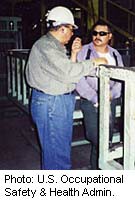
MONDAY, Sept. 20 (HealthDay News) —
You don’t necessarily have to sweat it out at the gym for hours every week to have a healthy heart. If your job keeps you relatively active, you’re reaping heart benefits, suggests new research.
In fact, the study found that men who were moderately active at work were 10 percent less likely to develop heart failure, while women who were moderately active at work were 20 percent less likely to develop heart failure.
Not surprisingly, the study found that the best of both worlds — physical activity during leisure time and work activity combined — led to even greater heart health.
“We showed that leisure activity and occupational activity and daily walking to and from work can reduce the risk of heart failure,” said the study’s senior author, Dr. Gang Hu, an assistant professor and director of the Chronic Disease Epidemiology Lab at the Pennington Biomedical Research Center in Baton Rouge, La.
He and his colleagues note that their study may be the first to show that physical activity at work — and commuting to work — protect against heart failure in the same way that leisure-time exercise does.
Results of the study appear in the Sept. 28 issue of the Journal of the American College of Cardiology.
Hu, with lead author Yujie Wang, and the rest of their team reviewed data from two large groups of Finnish men and women. Just over 28,000 men and 29,874 women were included in the study.
The study volunteers were between 25 and 74 years old, according to the study. All filled out surveys on their levels of physical activity. For work activity, “low” activity was defined as office work, or any job where you’re sitting most of the day. “Moderate” activity at work includes jobs that require a lot of standing and walking, such as a waitress or store clerk. “High” levels of activity at work came from heavy manual labor that included walking and lifting in industrial or farm jobs.
Commuting activity was also divided into three categories: “low” meant no walking or cycling, “moderate” included up to 29 minutes of walking or cycling to get to work, and “high” was walking or bicycling more than 30 minutes daily to commute to work.
For leisure activity, the study defined “low” activity as almost completely inactive, such as reading or watching TV. “Moderate” included some physical activity for more than four hours a week, such as walking, biking, or gardening, but did not include commuting activity. “High” leisure activity included vigorous physical activity, such as running, jogging, swimming, heavy gardening or competitive sports, for more than three hours a week.
After an average 18.4 year follow-up, the researchers found that heart failure developed in 1,868 men and 1,640 women.
After adjusting for known risk factors such as age, smoking, body mass index, blood pressure, cholesterol and more, the researchers found that physical activity was protective against heart disease.
Physical activity during leisure time tended to provide the most benefit. In men, moderate activity during leisure time reduced the risk of heart failure by 17 percent, and high levels of leisure-time activity dropped the risk by 35 percent. In women, the risk reductions were 16 percent and 25 percent, respectively.
Physical activity during work was also protective. In men, moderate activity reduced the risk of heart failure by 10 percent, while high physical activity during work reduced the risk by 17 percent. In women, moderate activity reduced the risk of heart failure by 20 percent.
The researchers found an association between high commuting activity and a reduction in heart failure in women, but not in men (after adjusting for other risk factors).
They also found that any two activities combined reduced the risk of heart failure even more.
Hu said that the leisure activity was probably more protective simply because those people who were engaged in leisure activities were just getting more exercise.
“This study confirms the message — the more activity the better. It doesn’t matter where it comes from,” said Dr. Michael Davidson, director of preventive cardiology at the University of Chicago Hospital in Illinois.
“When thinking about increasing physical activity, people don’t always think about increasing their activity at work, but any activity — to and from work, at work or leisure activity — can reduce your risk of heart disease,” said Davidson.
Hu suggested that people try to increase physical activity during work time, especially because many people now spend the day sitting, using computers.
More information
To learn more about physical activity and its effects on the heart, visit the American Heart Association.

